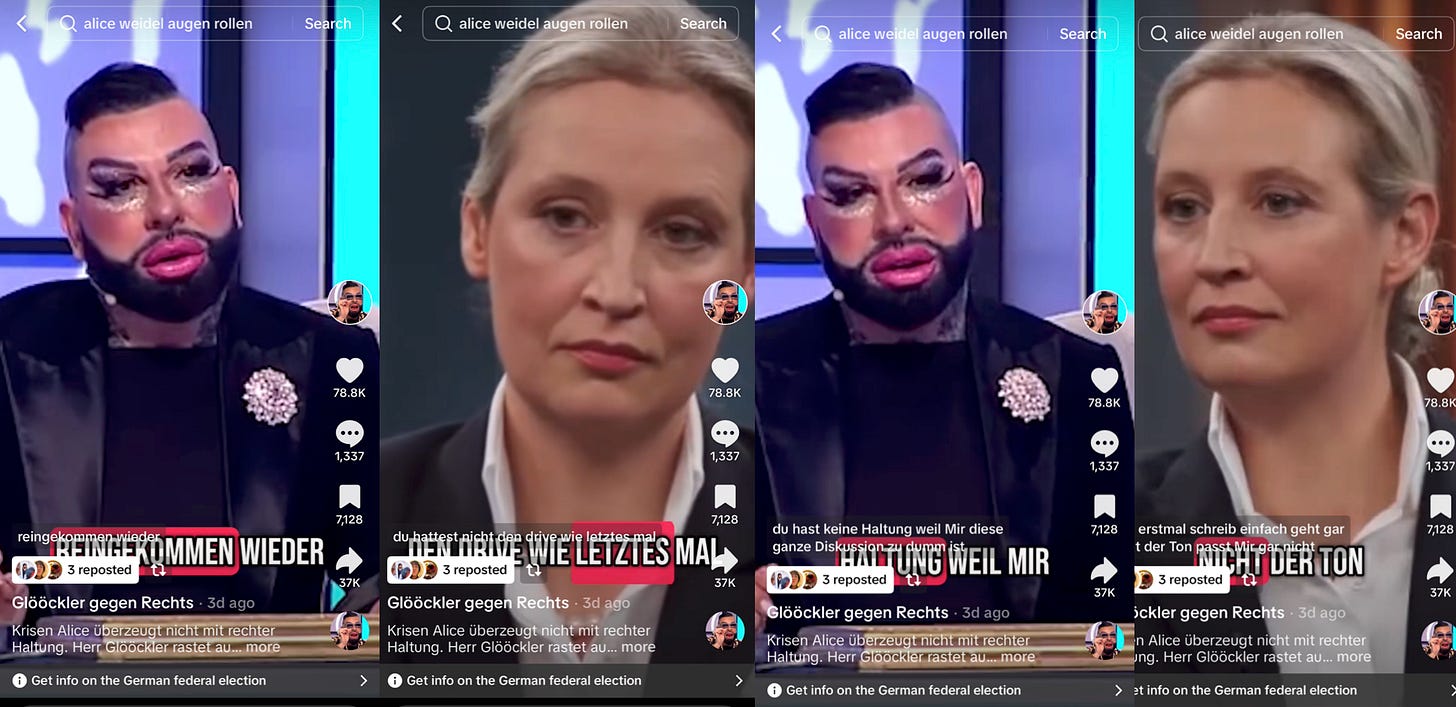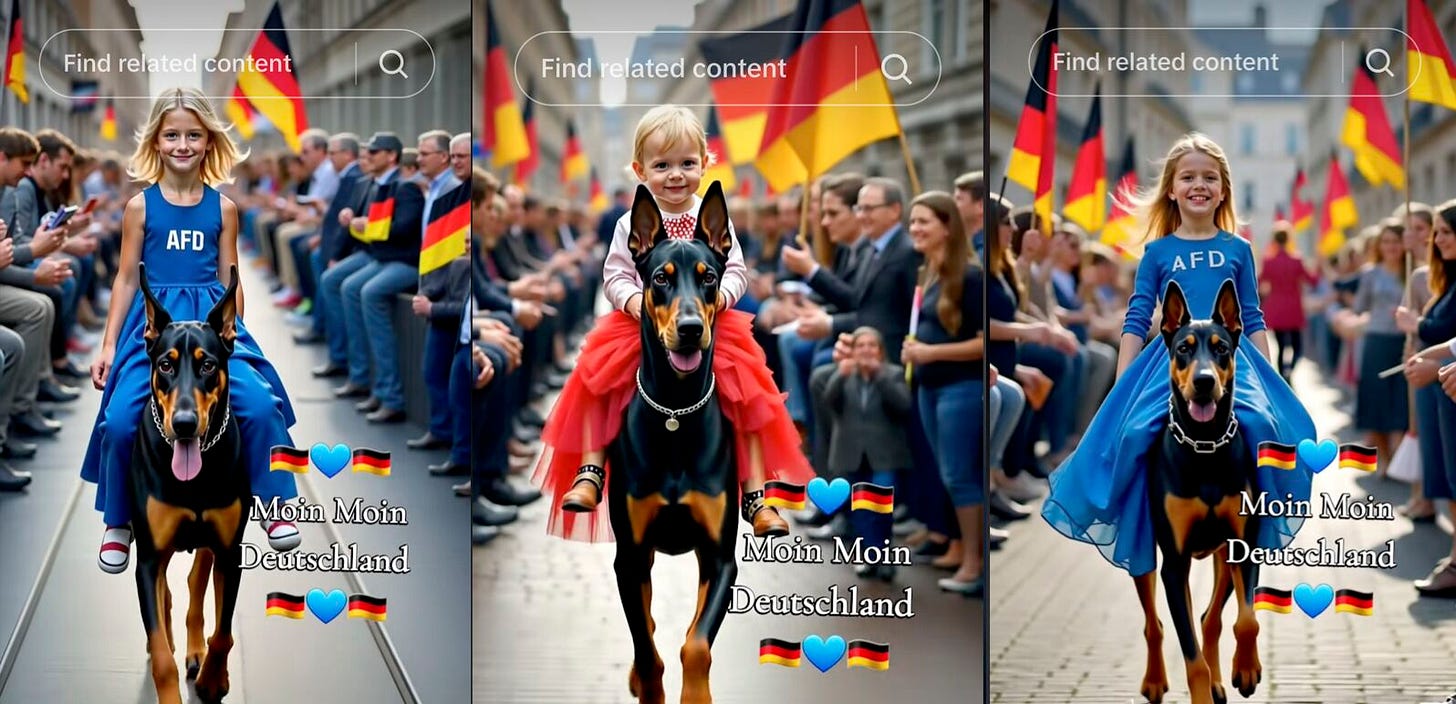Hello.
You are reading Understanding TikTok. It is me, Marcus. Germany is electing on February 23 (Politico). I am checking political vibes on German TikTok these days. Parties, politicians and supporters have started to fully embrace TikTok with still-chancellor Olaf Scholz and team going fully ballistic –– within the scope of his possibilities.
❤️ ReclaimTikTok: Mission accomplished
💙 Synthetic Propaganda: AfD Slop
❤️ Mission accomplished: TikTok reclaimed √
After extensive media coverage concerning the dominance of Germany’s right-wing extremist party AfD on TikTok (#123) several attempts of countermovements could be observed in the German part of TikTok (#126) throughout 2024, most revolving around #ReclaimTikTok (70.7K post).
While hashtag activism already felt a bit dated in 2024 with hashtags losing their relevance on the platform (TikTok Audit) democratic creators opposing the AfD have demonstrated a steep learning curve concerning platform specifics and meme-driven amplifying strategies in recent months. These include active trolling, mocking and comment bombing. Trending sounds, memes and vernaculars are produced, adapted and amplified. Here are some recent examples of political communication on TikTok beyond traditional and or official accounts.
🧠 German Brainrot
Between November 2024 and January 2025 videos featuring rendered animals with German language voiceover gained traction on the platform (Know Your Meme). A video featuring a rendered pigeon inside a supermarket buying daily items while being narrated by an AI-generated German voice received roughly 9 million plays and 1 million likes in two months. Many variations of this absurdist Germanrot content – referencing brain rot (Wikipedia) – occurred. Aidan Walker going more into detail on Germanrot here (Video 4:42 min).
A new sort of politically charged content including rendered animals could be observed in the last couple of days. On February 3 user @germanbrain2 uploaded a first video on his account. It includes a pigeon in a bathroom discussing AfD chancellor candidate Alice Weidel, her female partner and – according to the pigeon – a perceived inconsistency when contrasting her lifestyle to the political program her party stand for.
The video has garnered 220.7K views in three days. The account demonstrates a successful combination of a temporary meme and political content suited for the specific platform and its target audience.
🎷 Remix featuring Glööööckler
Stitches and duets including AfD personal and creators that were meant to debunk or oppose the party have been quite common on the platform. Yet many of these lacked a particular entertaining aspect.
Some days ago the account @glockeler.gegen.rechts started posting videos. These include stolen video snippets from a fashion reality competition series featuring German fashion designer and entrepreneur Harald Glööckler, well known for – well – basically his face. He underwent numerous cosmetic surgeries to change his face according to his own ideas. Snippets of Glööckler (who is well-known for his temper) are edited in order to appear as if he directly reacts to several AfD politicians criticizing them. The editing is well executed, the content is entertaining and delivers enough hooks to keep users engaged even after the initial “shit, look at that”-moment.
🥁 Deutsche Sound Propaganda
TikTok is a sound-driven platform. Sound is its backbone. German politics has embraced that, examples range from Pro-AfD folk songs to leftist techno-remixes of German politician Gregor Gysi (84.3K Likes). Interestingly though more and more users not only re-use given sounds but compose political protest songs.
User @KeMax set up an account November 22, 2024. Since then he has published six videos with songs criticising Friedrich Merz, chancellor candidate for the Christian Democratic Union of Germany. Until now his songs only reach a very limited amount of users (1,591 Likes), yet he stands pars pro toto for a new breed of politicized musicians.
All these examples (there are way more) show creative and platform-specific forms of political communication outside given structures and institutions. They demonstrate how TikTok serves as an important third space for political discourse that keeps evolving rapidly.
💙 AfD Slop
Since Hurricane Milton in 2024 we are in the midst of the the ‘fuck it’ era of AI slop (Jason Koebler) where a lot of people actually do not care if images are “real” or not as long as they feel real. I have written about AI Slop in October 2024 (#135) but only recently has my For You Page been infused with more generative AI videos promoting the German far-right party AfD, their worldwide and aesthetics.
Several state associations of the AfD have used generative AI to produce campaign videos or posters as a fast and convenient way to create tailored content. AI-generated clips here serve as nostalgia machines and emotional cliche amplifiers with imagery referencing historic aesthetics from the 19th and 20th century. Roland Meyer (Bluesky) has written about that (Geschichte der Gegenwart).
Besides these official examples, supporters produce variations of low quality media using generative artificial intelligence to help amplify pro-AfD messages. These sometimes bizarre AI fan productions (think of blond kids with blue AfD dresses riding on Doberman dogs going backwards in a parade of German flag waving adults) capture attention.
But they do more: the imagery combines elements of nationalism, strength, clear enemies and emotional appeal to promote the AFD as a protector of Germany’s heritage and future. The use of children and animals humanizes the party's image. By embedding these elements in celebratory and positive contexts, the images aim to soften the AFD’s controversial reputation and normalize its ideology.
This kind of tailoring can not be achieved with normal stock images. Instead it creates a unique *hyperreal aesthetic that feels uncanny, simplistic, meme-infused and very platform-specific. Here is a good article on how to read an AI image: Salvaggio, Eryk. 2023. How to Read an AI Image: Toward a Media Studies Methodology for the Analysis of Synthetic Images. In: IMAGE. Generative Imagery: Towards a ‘New Paradigm’ of Machine Learning-Based Image Production, 19(1): 83–99. DOI: https://doi.org/10.25969/mediarep/22328
* Hyperreal is seen as a condition in which what is generally regarded as real and what is understood as fiction are seamlessly blended together in experiences so that there is no longer any clear distinction between where one ends and the other begins
🤍 What else?
The TikTok “ban” as fiction. How legal and political symbolism created the “ban” narrative (Verfassungsblog)
Doug’s winter party (Dexerto)
TikTok Stole Our Hearts, but Can It Last? (Wired)
TikTok User Age, Gender, & Demographics (Exploding Topics)
TikTok-Zahlen zur Bundestagswahl 2025, KW 05 (German)
Thanks for reading. Speak soon. Ciao, Marcus










I have not seen anything more artisticly elaborate than German brainrot in a while
We are seeing a bunch of AfD slop and AI hyperrealism!